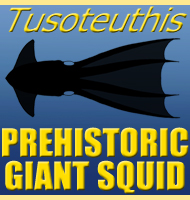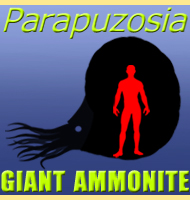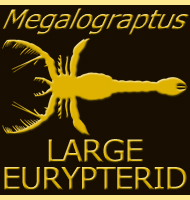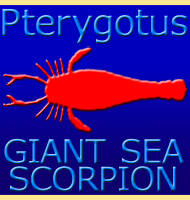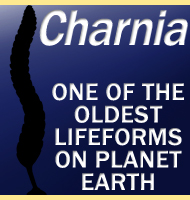


Cameroceras
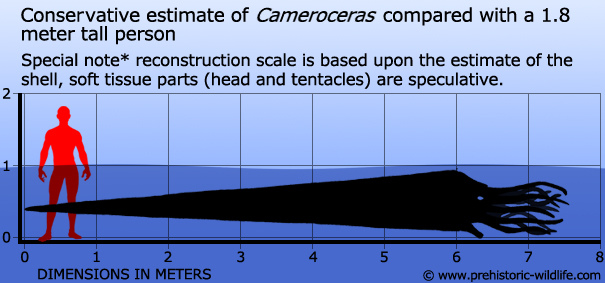
Name:
Cameroceras
(Chambered horn).
Phonetic: Cam-eh-ro-seh-rass.
Named By: Timothy Abbott Conrad - 1842.
Classification: Mollusca, Cephalopoda,
Nautiloidea, Endocerida, Endoceratidae.
Species: C. trentonense
(type), C. alternatum, C. hennepini, C. inaequabile, C.
inopinatum, C. motsognir, C. stillwaterense, C. turrisoides.
Diet: Carnivore.
Size: Modern estimates place the shell length at
about 6 meters long, though in the past this has been estimated
to have been larger.
Known locations: Fossils known from Europe, North
America and mainland China, suggesting a cosmopolitan distribution.
Time period: Middle Silurian.
Fossil representation: Shells.
Cameroceras
is widely regarded as one of if not the largest orthocone cephalopods
to ever exist. Unfortunately only estimates for the upper size of the
animal exist. More modern interpretations at the end of the twentieth
century estimated the length of the shell at around six meters long,
though estimates from earlier in the twentieth century suggested that
it was as much as nine and even eleven meters long. Even at six
meters long however, Cameroceras is still one of the largest
cephalopods that we know about, especially for one that lived in the
Ordovocian period.
Cameroceras
was a cephalopod, a type of mollusc that includes the octopuses,
squids and cuttlefish that we know today, and because of this we can
infer a few things about the living animal. The head of the animal
would have been soft muscular tissue situated at the opening of the
hard cone-like shell, with the mantle (main body) lying within
the shell for protection. Tentacles would have grown from the base of
the head like in a modern cuttlefish, and these tentacles would have
been used to seize and manipulated prey as the Cameroceras prepared to
feed. At the base of these tentacles within the buccal mass
(analogous to the mouth) a hard keratinous beak would have bitten
into the bodies of its prey, and would have been so strong that it
could crunch straight through the hard shells of other orthocones or
even the hard supposedly armoured exoskeletons of eurypterids. Within
the beaks of modern cephalopods a ‘toothed’ tongue is used to rasp
out soft tissue from within the preys shell, though it is not known
for certain if Cameroceras had this feature. In addition to
eurypterids and other Ordovician cephalopods, Cameroceras may have
also hunted early jawless fish.
Occasionally
when Cameroceras has been shown in popular culture it has been depicted
as having poor eyesight. This is mostly speculation as the eyes of
Cameroceras have never been found, but it is a curious decision to
suggest such a thing since most cephalopods are visually orientated
predators, and some of them actually have quite exceptional
eyesight. We do not know for certain how good the eyesight of
Cameroceras was but other cephalopods are noted for having a great
ability to pick out colours as well as gather and filter light to
see in very dark water.
The
history of Cameroceras as a taxon goes all the way back to 1842 at
a time when the science of palaeontology was still very much in its
infancy. This is why Cameroceras has also been dubbed a
‘wastebasket taxon’ because so many other large orthocone fossils
have been attributed to the genus when they should not have been.
Many of these specimens have since been re-labelled as belonging to
other genera, however some genera of large orthocones such as
Endoceras have been speculated to actually be synonyms to Cameroceras,
suggesting that the fossils may actually belong after all.
Further reading
- The Lower Silurian Cephalopoda of Minnesota. J. M. Clarke
- In: E.O. Ulrich, J.M. Clarke, W.H. Scofield &
N.H. Winchell The Geology of Minnesota. Vol. III, Part II,
of the final report. Paleontology. Harrison & Smith,
Minneapolis. pp. 761–812. - 1897.
- Status of Endoceroid Classification. Journal of Paleontology 29:
329–371. - Rousseau H. Flower - 1955.
- Size of Endocerid Cephalopods. Breviora Mus. Comp. Zool.
128: 1–7. - C. Teichert & B. Kummel - 1960.
- Middle and Upper Ordovician nautiloid cephalopods of the Cincinnati
Arch region of Kentucky, Indiana, and Ohio. - U.S. Geological
Survey. - R. C. Frey - 1995.
-
The cephalopods of the Kullsberg Limestone Formation, Upper Ordovician,
central Sweden and the effects of reef diversification on cephalopod
diversity. - Journal of Systematic Palaeontology. 17 (12): 961–995. -
Bj�rn Kr�ger & Martina Aubrechtov� - 2019.
----------------------------------------------------------------------------
Random favourites
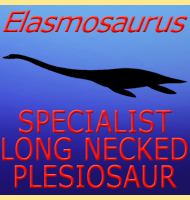 |
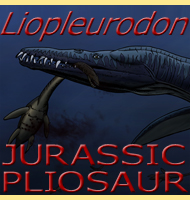 |
 |
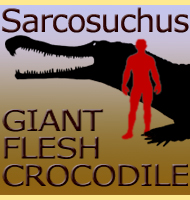 |
